Day 27: An Eye-Opening Incident in Beijing
The Chinese understand rail and how trains can move people – a lot of people – quickly and efficiently. We arrived in Beijing at a grand old rail station with some 30 trains appearing on the constantly-changing departure board, all scheduled to depart at varying times in just the next 120 minutes.
First order of business: a visit to Tiananmen Square which, days later in Shanghai, was described to me by a local Chinese as “the political epicenter of China”.
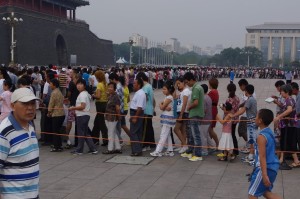 At one end of this vast area is the mausoleum for Mao Zedong – he is always referred to as “Chairman Mao” in China, never simply as “Mao” – and this is the line of people waiting to enter that building. I have no idea how many were standing there, but our guide estimated it would be a two-hour wait from this point … and, he emphasized, this was a slow day with less-than-normal crowds.
At one end of this vast area is the mausoleum for Mao Zedong – he is always referred to as “Chairman Mao” in China, never simply as “Mao” – and this is the line of people waiting to enter that building. I have no idea how many were standing there, but our guide estimated it would be a two-hour wait from this point … and, he emphasized, this was a slow day with less-than-normal crowds.
I should add here that each of us had been given a small radio receiver with an ear piece. Our guide carried a small transmitter and could describe what we were seeing in a normal voice that we could easily hear through this device.
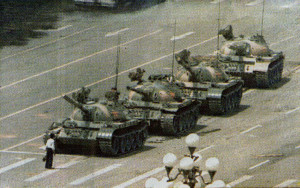 It was at this point, as our group had briefly stopped to reassemble, that I asked our guide where exactly in the square was this famous photograph taken showing the one man standing in front of a tank during the 1989 protest demonstrations.
It was at this point, as our group had briefly stopped to reassemble, that I asked our guide where exactly in the square was this famous photograph taken showing the one man standing in front of a tank during the 1989 protest demonstrations.
A stricken look came over the guide’s face. Finally, after staring off into space for several seconds – the guide said, with lengthy pauses between every word, “ Well … you see … China … is … a very … special … place.” There followed a very awkward silence for several seconds, then the guide nodded carefully in the direction of a man standing 30-40 feet away from our group and holding something up to his ear.
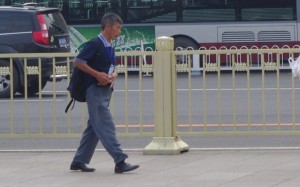 Finally, when the man turned and started walking away, I snapped this photo of him. Our guide – obviously still very uncomfortable – muttered the words “secret police” under his or her breath. Clearly, the concern was that this man had been eavesdropping on what was being said to our group. (I am obviously making an effort to obscure the identity of our guide and would like to add here for the record that at no time did our guide say one derogatory word about the Chinese government.)
Finally, when the man turned and started walking away, I snapped this photo of him. Our guide – obviously still very uncomfortable – muttered the words “secret police” under his or her breath. Clearly, the concern was that this man had been eavesdropping on what was being said to our group. (I am obviously making an effort to obscure the identity of our guide and would like to add here for the record that at no time did our guide say one derogatory word about the Chinese government.)
And that said, I will now acknowledge that there are video cameras mounted in and around most public areas in U.S cities – Times Square in New York, for example – as well as most other major cities around the world. Nevertheless, I could not escape the uncomfortable feeling — on this particular day, in this particular location and following this incident — that these cameras were primarily there for reasons other than public safety.
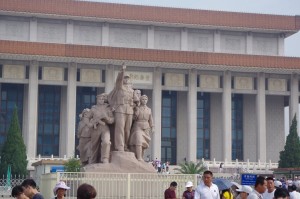 Setting all that aside, however, Tiananmen Square is a must-see for anyone visiting Beijing. It is impressive for it’s size alone, with the national museum on one side, a massive building where the government meets on the other and Mao’s mausoleum dominating the far end. There are the usual and expected heroic monuments to the workers and, of course, always the huge crowds.
Setting all that aside, however, Tiananmen Square is a must-see for anyone visiting Beijing. It is impressive for it’s size alone, with the national museum on one side, a massive building where the government meets on the other and Mao’s mausoleum dominating the far end. There are the usual and expected heroic monuments to the workers and, of course, always the huge crowds.
Next: A visit to the not-very Forbidden City.

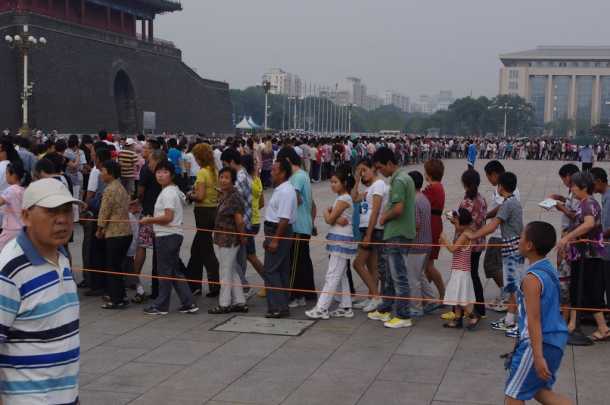
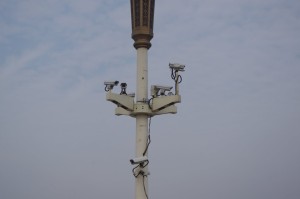


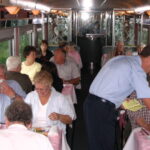
Of course not. But, when you have grown to adulthood in a free, open and safe society, even a seemingly insignificant incident like this is startling. And sobering. And, I thought, worth discussing.
Did you forget that China is a DICTATORSHIP?